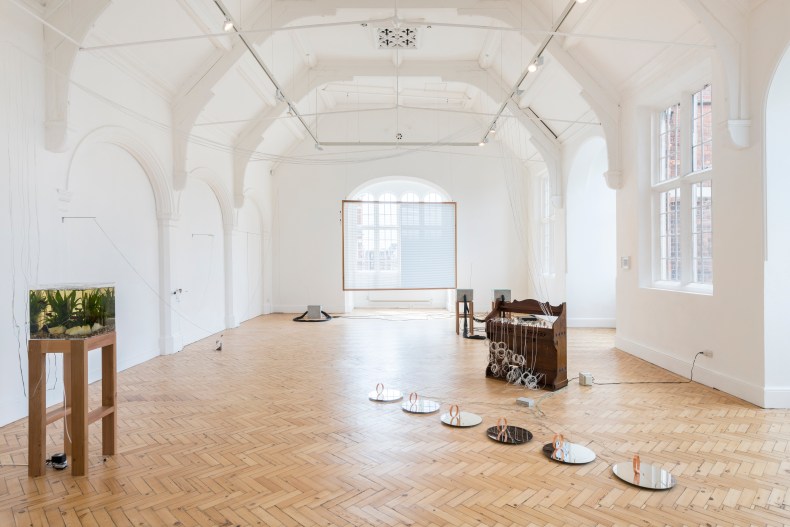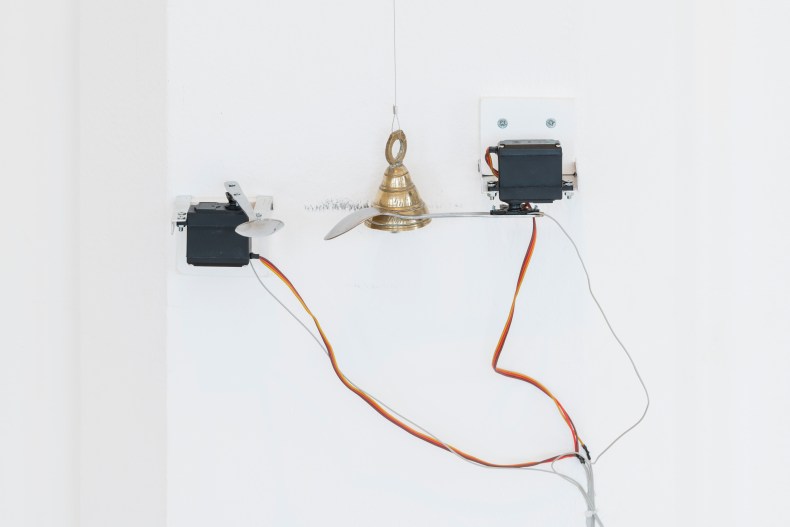In June 1962, the San Francisco Tape Music Center hosted the premiere of an unusual new composition. Ramon Sender’s Tropical Fish Opera involved a tank full of ichthyoids with the five lines of a musical score drawn on each side. As the fish swam to and fro, a group of four live musicians struggled to perform the notes indicated by the position of the creatures on the staves, interpreting their movements as if it were a living manuscript. Over half a century later, Yuko Mohri is taking out the middlemen.

Installation view of ‘Yuko Mohri: Voluta’, at Camden Arts Centre, 2018. Photo: Damian Griffiths; courtesy Camden Arts Centre
To walk into Mohri’s show at Camden Arts Centre is to enter a complex cybernetic mechanism, an apparently self-playing orchestra of chimes and clacks and heaving drones. Over the large south-facing window of one gallery, a set of venetian blinds clatters and clicks as its slats open and close; it is directed by a remote-control device triggered by the movement of a teaspoon striking a tiny Indian brass bell every time the motor it is attached to receives a signal from a circuit formed by the rotation of another spoon and a loose-hanging steel chain. Across the room, a set of compasses are spun by solenoids that are triggered by the air wheezing through the pipes of an organ, the pedals of which are powered by the signals from a set of eight light sensors stuck to the side of an aquarium. Within the aquarium, affecting the light signals by hitting those sensors with their tail fins, swim two small tropical fish – with no human interpreters to mediate their music-making.
Mohri first came to Camden Arts Centre in 2016 for a two month-long residency, after a similar residency at the Victoria & Albert Museum earlier that summer. For her first solo show in London the following year at the White Rainbow gallery in Fitzrovia, she drew inspiration from the ad-hoc repairs she found applied to leaky water pipes in Tokyo metro stations. Beside photographs of elaborate assemblages of gaffa tape and plastic sheeting strung up in the underground corridors of Shinjuku and Akasaka, she built large-scale sculptures from boots and buckets and pumps and plastic tubes, which ferried water across the gallery in a manner equally inventive and precarious. At that show – with the unsteady percussion of dripping water, a dangling metal chime poised to be struck – the musical element was implicit. In the case of Voluta, it is central.

Installation view of ‘Yuko Mohri: Voluta’, at Camden Arts Centre, 2018 Photo: Damian Griffiths; courtesy Camden Arts Centre
The title of the show (and of the work in the main gallery) refers simultaneously to the spiral shell of a sea snail and to the similarly scroll-like ornaments found on ionic columns and a violin’s pegbox. Two untitled silkscreen prints on the walls collage images of these scrolls with the wheels of cassette tapes and coils of electrical wires, suggesting an intermeshing of the ancient and modern, animal and human, in spirals within spirals ad infinitum. Like Mohri’s other installation in Camden Arts Centre, in its Reading Room – Oni-bi [fen-fire] (2013–17), a network of interlinked electric fans, charged threads, and a customised glockenspiel, its keys struck as the threads are blown into a wire mesh – Voluta suggests the possibility of a music made by non-human actors: fish, sunlight, the blowing wind. But as compelling as the indeterminate counterpoint of organ chords, bells, and clattering blinds sounds, I can’t help but feel Mohri is just as enchanted by the superfluous elements in the system: the spinning compasses silently defying geography, the floral patterns engraved on the side of her reed organ from the 1930s, the shell-like scroll on the head of a violin. Ornament, here, is not a crime but a charm, a brief flight of fancy.
‘Yuko Mohri: Voluta’ is at the Camden Arts Centre, London, until 16 September 2018.












![Masterpiece [Re]discovery 2022. Photo: Ben Fisher Photography, courtesy of Masterpiece London](http://zephr.apollo-magazine.com/wp-content/uploads/2022/07/MPL2022_4263.jpg)
Apollo at 100